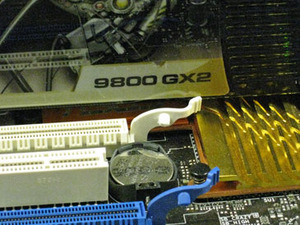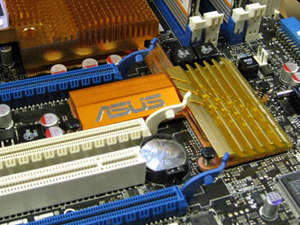Heat
We don't normally comment much on heat with graphics cards, but the GeForce 9800 GX2 is an exception because the heat this card produces caused us some headaches along the way. We encountered a number of heat-related crashes, hard locks and instabilities with our Asus Striker II Formula motherboard.The thing was, these problems were limited to only when the GeForce 9800 GX2 was installed in the board. With two GeForce 8800 GTS 512MB cards in SLI, there were no problems and the story was the same with the GeForce 8800 Ultra as well – we're 100 percent certain that the problems we encountered were entirely related to the installation of the GeForce 9800 GX2.
We witnessed temperatures in excess of 90 degrees Celsius on both the nForce 200 chip and the south bridge on the Asus motherboard – this triggered the company's overheat protection feature that automatically shuts down the motherboard to prevent long term damage.
Throughout all of our testing, we closely monitored GPU temperatures after we first encountered stability problems and they never exceeded 85 degrees Celsius, which is pretty good for a graphics card—especially one with two GPUs so closely packed together. In fact, Nvidia says the point where the GPU starts to throttle itself down is when the core reaches a temperature of 105°C for reference purposes, so there's still quite a bit of headroom.
A fan placed directly above the south bridge prevented these heat related problems from cropping up again. And after a lot of time spent stress testing GeForce 9800 GX2 cards in other motherboards (such as XFX's nForce 780i SLI and nForce 790i SLI boards, as well as the Gigabyte GA-X38-DS5), we have come to the conclusion that system instability may occur on nForce 700-series motherboards with the nForce 200 chip located in between the top two PCI-Express x16 slots.
In that location, the chip is right underneath the GeForce 9800 GX2 and, with the card being covered in what is essentially a big heatspreader, a heat pocket is created underneath the card.
The problem as I see it is that when Nvidia set the design guidelines for partners to adhere to when designing nForce 780i SLI motherboards, Nvidia gave engineers the freedom to place the nForce 200 chip wherever they pleased – there were no limitations imposed. During my conversations with Nvidia's nForce 780i SLI engineers last October, I asked on several occasions whether the nForce 200 chip had a significant TDP because I had spoken to several motherboard engineers that had complained about the increased TDP requirements for the chipset.
Every time I asked the question, I was told that the TDP increase was insignificant. That may be the case with the Nvidia-designed board used by some partners, but it's definitely not the case here with a GeForce 9800 GX2 installed in the Asus Striker II Formula. The problem for motherboard engineers was that they probably didn't know a great deal (if anything) about the GeForce 9800 GX2 and the amount of heat it produces. And because Nvidia imposed no strict limitations on the placement of nForce 200, the problem has come out into the open.
It's sad that we have to put a downer on this card's performance, but we have to make you aware of what you may encounter if you're using one of the more popular nForce 780i SLI motherboards on the market. This isn't XFX's fault, or even really Asus's fault either – it's just a bit of a mess that wouldn't have come about if Nvidia had imposed design limitations on the placement of the nF200 chip.
Conclusions
The XFX GeForce 9800 GX2 is a good implementation of Nvidia's GeForce 9800 GX2 design and delivers some unprecedented levels of performance. In many respects, the GeForce 9800 GX2 has left AMD in a strange position, because it was only a matter of weeks ago when it challenged for the performance crown once more. The Radeon HD 3870 X2, while cheaper, has been beaten into the ground pretty comprehensively across the board here – there are a few glimmers of hope, but on the whole it doesn't look very good.I think it's time for AMD to head back to the drawing board because it really has fallen a long way behind Nvidia in recent months. The R600 generation of products just haven't been brilliant for AMD and it's been clear for a while that Nvidia has been sandbagging releases, doing just enough to keep AMD at bay while it prepares for an impending battle for supremacy with Intel.
At around £435 including VAT (and delivery to regular contributors to the bit-tech community), the XFX GeForce 9800 GX2 represents reasonable value for money for a high end card, but it's one of the more expensive GeForce 9800 GX2s on the market. If you're just after a white box, this probably isn't the card for you.
There's also the fact that it's over £170 more expensive than the cheapest Radeon HD 3870 X2s, although they're all on pre-order. The cheapest you can pick up a 3870 X2 for today is around £265 (inc. VAT). I guess you have to pay for the privilege of the best performance on the market... and that's exactly what's happening here – Nvidia can charge what it wants for this card, just like it did with the GeForce 8800 Ultra.
Where it gets interesting is when you look at the price of a pair of GeForce 8800 GTS 512MB cards – BFG Tech's GeForce 8800 GTS OC 512MB card is available for just over £170 (inc. VAT) for example and that's one of the cheapest on the market at the moment. A pair of those will cost you less than a GeForce 9800 GX2 and will, by and large, deliver a very similar gaming experience in most scenarios, but they won't offer HybridPower when motherboards and chipsets supporting the technology become available.
Final Thoughts...
Overall then, if you're after the fastest single card solution on the market, the GeForce 9800 GX2 is it and if you don't have an nForce motherboard, it's currently the only way to enable SLI technology on other motherboards and could quite possibly be the fastest graphics solution in that situation as well, given some of the performance differences between the GeForce 9800 GX2 and the Radeon HD 3870 X2.If you do have an nForce motherboard and aren't likely to suffer from the documented heat problems, there are options available for less money that deliver similar performance in most scenarios, but the GeForce 9800 GX2 isn't really about delivering value for money. What it is about is delivering the fastest graphics card on the market and, in that respect it delivers. And what's more, Nvidia will soon release a driver to enable Quad SLI on a pair of GeForce 9800 GX2s to potentially deliver more performance than three GeForce 8800 GTX/Ultra cards – we just hope Quad SLI is better than it was last time.
- Features
- x
- x
- x
- x
- x
- x
- x
- x
- -
- -
- 8/10
- Performance
- x
- x
- x
- x
- x
- x
- x
- x
- x
- -
- 9/10
- Value
- x
- x
- x
- x
- x
- -
- -
- -
- -
- -
- 5/10
- Overall
- x
- x
- x
- x
- x
- x
- x
- -
- -
- -
- 7/10

MSI MPG Velox 100R Chassis Review
October 14 2021 | 15:04











Want to comment? Please log in.